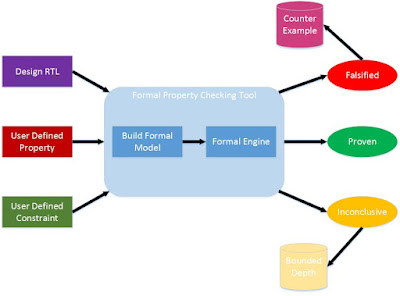What is Formal Verification through Model Checking? [1/2]
Hi All,
Sorry for the delay in the post. But you know, good content takes it's own time ;)
Today we will discuss about a relative new technology for verification, Formal Verification through Model Checking. I hope, you guys will know the fundamentals or theory of the Model Checking, by reading this post.
Sorry for the delay in the post. But you know, good content takes it's own time ;)
Today we will discuss about a relative new technology for verification, Formal Verification through Model Checking. I hope, you guys will know the fundamentals or theory of the Model Checking, by reading this post.
What is Formal Verification?
Before knowing about Model Checking, we must know about Formal Verification.
- Formal Verification is an algorithmic based approach, to logic verification, that exhaustively proves functional properties of a design.
- Focus is not on Stimulus, but rather correctness of the reference.
- Proves or disapproves, correctness of the design mathematically.
- Most commonly used algorithms : BDD/ROBDD, SAT Solvers (We may talk about this algorithms in subsequent blog posts)
There are 2 types of the Formal Verification :
- Equivalance Checking - Verifies Functional Equivalence of 2 designs, which are at smae or different abstraction level. Like RTL to RTL, RTL to Gate Level, Gate Level to Gate Level, Gate Level to Post Layout. (Already used in Industry, with stable Tool Support)
- Model Checking - Verifies whether the implementation satisfies property of the design or not.
Model Checking Basics
 |
| Model Checking Block Diagram |
As shown in the above image, there are primarily 3 basic elements of the Model Checking : User Defined Property, User Defined Constraint, RTL Design.
All 3 elements are provided to the Model Checking Tool and tool builds a model, from this data and tries to prove all the properties exhaustively, on Formal engines.
There are basically 2 parts of the Model Checking :
There are basically 2 parts of the Model Checking :
- Simulation Based Reset State - Most sequential designs do not operate properly without a reset procedure which establishes a valid starting state. We need to apply the same sort of initialization when running formal analysis in order to get valid results. If no initial state is specified, the default is to start with an initial state where all the state holding elements are of value X. This may produce false failures because the formal analysis was based on an initial state that can never occur in the real design.
- Tool Driven Formal State - In this state, tool evaluates the assertion. This state is not Simulation driven.
Properties & Constraints
Properties -
- Assertions, which will be checked exhaustively by the Model Checking Tool.
- Can be written in many languages like SVA, PSL or TCL also.
- Safety Property - "Something will never happen" or "Something always happens" type of property. So these type of properties can be violated in finite run and hence they are comparatively easy for tool to verify.
- Liveness Property - "Something will eventually happen" type of properties. So these type of properties can be violated in infinite run, and hence they are comparatively complex for tool to verify.
Example of the Safety Property -
"grant signal will always be asserted exactly after 2 clock cycles of assertion of request signal"
assert property (@ (posedge clk) (req -> ##2 grant));
Example of the Liveness Property -
"red traffic signal will eventually be converted into green traffic signal"
assert property (@ (posedge clk) (red_traffic |-> ##[1:$] green_traffic));
Constraints -
- Properties, which must be true for design to be operated properly.
- Can be written in many languages like SVA, PSL or TCL also.
- Tool will always try to generate those input stimulus, which satisfies the constraints.
- Constraints can be written on the cut-points, input of the design and output of the blackboxed modules only.
 |
| Over & Under Constrained Scenarios |
It is very important to identify valid & required constraints, as otherwise, we may get errorneous scenario like :
- Over Constrained - Some legal input patterns are not applied to the design, which may lead to false proofs of the assertion and may miss some bugs.
- Under Constrained - Some illegal input patterns are applied to the design, which may lead to false failure of the assertion and wastage on debugging time.
Example of the Valid Constraint :
"Valid Register addresses are only from 8'h0 to 8'hff. And those registers are connected to the APB interface"
assume property (@(posedge PCLK) (PADDR inside {[32'h0000:32'h00ff]}));
-----------------
So guys, we will end this post, at this point. I believe this information is sufficient to get the basic idea on the Model Checking.
Do visit the blog, as in the next post, I will give you the idea on Model Checking Advantages, Limitations & It's Outputs
Feel free to comment any question, if you have.


Comments
Post a Comment